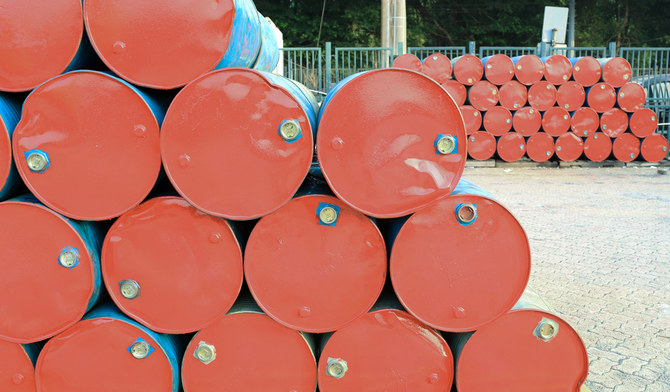
The drone was downed in international airspace over the Strait of Hormuz by an Iranian surface-to-air missile
Also propelling oil higher was a decline in US crude inventories and the prospect of prolonged supply restraint by producer group OPEC and its allies
LONDON: Oil rose more than 3 percent toward $64 a barrel on Thursday after Iran shot down a US military drone, raising fears of a military confrontation between Tehran and Washington.
Expectations that the US Federal Reserve could cut interest rates at its next meeting, stimulating growth in the world’s largest oil-consuming country, and a drop in US crude inventories also supported prices.
US crude was up 5.8 percent at $59.91 per barrel, a three-week high. Brent crude was up 4.3 percent at $64.52 per barrel, also a three-week high, having earlier gained 3.4 percent to $63.93. US West Texas Intermediate crude rose $2.33 to $56.09.
“The risk of a military conflict in the Middle East has risen because of a ratcheting up of tensions between the United States and Iran,” said Abhishek Kumar of Interfax Energy in London. “Elsewhere, the US Federal Reserve has signaled its willingness to loosen monetary policy over the coming months, which is being perceived as favorable to oil demand.”
The drone was downed in international airspace over the Strait of Hormuz by an Iranian surface-to-air missile, a US official said. Iran’s Revolutionary Guards said the drone was flying over southern Iran. Tension has been rising in the Middle East, home to over a fifth of the world’s oil output, after attacks on two tankers near the Strait of Hormuz, a chokepoint for oil supplies. Washington blamed Tehran for the tanker attacks. Iran denied any role.
Concern about slowing economic growth and a US-China trade dispute has pulled oil lower in recent weeks. Brent reached a 2019 high of $75 in April.
The prospect of further rate cuts could prove the more significant factor for oil, said Petromatrix analyst Olivier Jakob, should Iran-US tension not escalate.
“The Fed and the cutting of rates is something that will provide more substantial support,” he said.
Also propelling oil higher on Thursday was a decline in US crude inventories and the prospect of prolonged supply restraint by producer group OPEC and its allies.
US crude stocks fell by 3.1 million barrels last week, more than analysts expected, the Energy Information Administration said on Wednesday.
OPEC and allies including Russia agreed this week to meet on July 1-2, ending a month of wrangling about the timing.
The coalition known as OPEC+ looks set to extend a deal on cutting 1.2 million barrels per day of production. The deal expires at the end of June.












